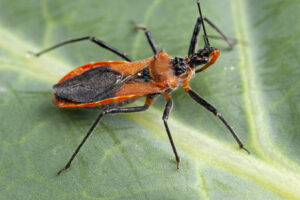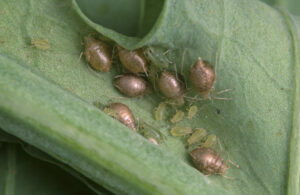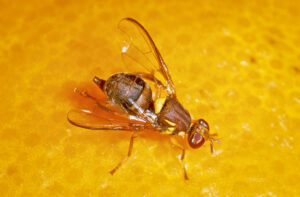
Why do we still have pests?
By Denis Crawford
I wrote an article in March 2009 titled ‘Why do we have pests?’ The main themes of that Pest Files were monoculture, invasive insects, suppression of beneficials, and resistance to pesticides. What has changed in the last 13 years?
Monoculture
Populations of herbivorous insects can increase dramatically when food availability is unlimited. A concentration of many thousands of food plants of the same type (i.e., a crop) is irresistible to plant-feeding insects. An infestation of herbivorous insects will damage those plants, which then affects crop yields, the profits of growers, and the cost to consumers.

(Supplied by Denis Crawford of Graphic Science)
Monoculture modifies the environment to such an extent that it not only favours some insect species (pests) but inhibits others (usually beneficial insects or “good bugs”). For example, the native plants which were in an area before a crop was planted may have harboured predators or parasites of a pest species. Removing such plants may cause beneficial populations to collapse. In recent years there has been increased interest in habitat gardening and diversity in gardens. Growing a diverse range of plants, and not having too many of the same plant growing next to each other, will result in a more diverse range of insect species. In natural systems it is normal for lots of different insects to occur, it is not normal for only a few kinds of insects to occur.
Invasive insects
When an insect is introduced into an area with few natural predators and parasites, and an unlimited food supply, it can become a severe pest. Predators such as lacewing larvae or ladybird beetles may tackle a new insect, but if they are not in sufficient numbers and there are no pest specific parasites or pathogens in support, they may lose the battle.

(Supplied by Denis Crawford of Graphic Science)
The solution to this problem in commercial agriculture and horticulture has been to introduce parasites specific to a particular pest. A good example of this is the invasive cabbage white butterfly (Pieris rapae) for which several parasitic wasps were introduced back in the 1940s. Biological control may not work on its own, which is why biocontrol is only one component of an integrated pest management (IPM) system.
Our biosecurity authorities do their best to keep invasive species out of Australia, but occasionally there are incursions. Brown marmorated stink bug (Halyomorpha halys) and varroa mite (Varroa destructor) are two examples. There is also considerable movement of pests within the country. For example, citrus gall wasp (Bruchophagus fellis) and grapevine moth (Phalaenoides glycinae) have found their way into Western Australia from the eastern states, almost certainly on plant material. Queensland fruit fly (Bactrocera tryoni) is now established in parts of Victoria where it was once rare, probably as a result of climate change.
Suppression of beneficials
Pest populations can reach outbreak proportions if beneficial organisms are suppressed or eradicated. Broad-spectrum pesticides kill beneficials just as efficiently as they kill pests. Some beneficial insects are even susceptible to ‘soft’ sprays such as horticultural oil and soap sprays. In other words, these ‘soft’ options are just as broad-spectrum as synthetic insecticides. To avoid this, it is always a good idea to carefully target the pest, rather than blanket spraying everything.
How can we encourage beneficial insects? Parasitic wasps in particular need a nectar feed from flowers. If no flowers are available when wasps need them, they will most likely leave the area. The encouragement and protection of beneficial insects remains paramount.
Resistance to pesticides

(Supplied by Denis Crawford of Graphic Science)
Pesticide applications usually don’t kill 100% of the target pest, which leaves a small number of survivors to reproduce and pass on the ability to survive pesticides to some of the next generation. Resistance can develop and become entrenched very rapidly in pests that produce a new generation every few weeks.
Pest insects and mites with short life cycles and high numbers of generations per year top the list of pests resistant to the most chemicals. The two-spotted mite (Tetranychus urticae) which has a life cycle of 1 – 4 weeks and 12 – 20 generations per year (depending on temperatures) is resistant to over 70 of the chemicals registered against it. The green peach aphid (Myzus persicae) is resistant to a similar number of chemicals.
This is not going to change any time soon. Pests will continue to build up resistance to pesticides, then new pesticides will be manufactured, and the pests will develop resistance to these. The best thing to do is manage pests in a way that does not solely rely on pesticides, which means IPM. Over the last 13 years a few new pests have arrived, or existing pests have increased their range, and a few pesticides have come and gone. The fundamentals of pest control remain the same. The encouragement of beneficial insects and other preventative strategies is key, and an integrated approach to pest management is always preferable to just relying on pesticides to do the work.
Main photo: Predators such as assassin bugs occur in healthy systems (Supplied by Denis Crawford of Graphic Science)
